Jie Liang
LSTC-MDA: A Unified Framework for Long-Short Term Temporal Convolution and Mixed Data Augmentation in Skeleton-Based Action Recognition
Sep 18, 2025Abstract:Skeleton-based action recognition faces two longstanding challenges: the scarcity of labeled training samples and difficulty modeling short- and long-range temporal dependencies. To address these issues, we propose a unified framework, LSTC-MDA, which simultaneously improves temporal modeling and data diversity. We introduce a novel Long-Short Term Temporal Convolution (LSTC) module with parallel short- and long-term branches, these two feature branches are then aligned and fused adaptively using learned similarity weights to preserve critical long-range cues lost by conventional stride-2 temporal convolutions. We also extend Joint Mixing Data Augmentation (JMDA) with an Additive Mixup at the input level, diversifying training samples and restricting mixup operations to the same camera view to avoid distribution shifts. Ablation studies confirm each component contributes. LSTC-MDA achieves state-of-the-art results: 94.1% and 97.5% on NTU 60 (X-Sub and X-View), 90.4% and 92.0% on NTU 120 (X-Sub and X-Set),97.2% on NW-UCLA. Code: https://github.com/xiaobaoxia/LSTC-MDA.
LocalDyGS: Multi-view Global Dynamic Scene Modeling via Adaptive Local Implicit Feature Decoupling
Jul 03, 2025Abstract:Due to the complex and highly dynamic motions in the real world, synthesizing dynamic videos from multi-view inputs for arbitrary viewpoints is challenging. Previous works based on neural radiance field or 3D Gaussian splatting are limited to modeling fine-scale motion, greatly restricting their application. In this paper, we introduce LocalDyGS, which consists of two parts to adapt our method to both large-scale and fine-scale motion scenes: 1) We decompose a complex dynamic scene into streamlined local spaces defined by seeds, enabling global modeling by capturing motion within each local space. 2) We decouple static and dynamic features for local space motion modeling. A static feature shared across time steps captures static information, while a dynamic residual field provides time-specific features. These are combined and decoded to generate Temporal Gaussians, modeling motion within each local space. As a result, we propose a novel dynamic scene reconstruction framework to model highly dynamic real-world scenes more realistically. Our method not only demonstrates competitive performance on various fine-scale datasets compared to state-of-the-art (SOTA) methods, but also represents the first attempt to model larger and more complex highly dynamic scenes. Project page: https://wujh2001.github.io/LocalDyGS/.
VisualQuality-R1: Reasoning-Induced Image Quality Assessment via Reinforcement Learning to Rank
May 20, 2025



Abstract:DeepSeek-R1 has demonstrated remarkable effectiveness in incentivizing reasoning and generalization capabilities of large language models (LLMs) through reinforcement learning. Nevertheless, the potential of reasoning-induced computational modeling has not been thoroughly explored in the context of image quality assessment (IQA), a task critically dependent on visual reasoning. In this paper, we introduce VisualQuality-R1, a reasoning-induced no-reference IQA (NR-IQA) model, and we train it with reinforcement learning to rank, a learning algorithm tailored to the intrinsically relative nature of visual quality. Specifically, for a pair of images, we employ group relative policy optimization to generate multiple quality scores for each image. These estimates are then used to compute comparative probabilities of one image having higher quality than the other under the Thurstone model. Rewards for each quality estimate are defined using continuous fidelity measures rather than discretized binary labels. Extensive experiments show that the proposed VisualQuality-R1 consistently outperforms discriminative deep learning-based NR-IQA models as well as a recent reasoning-induced quality regression method. Moreover, VisualQuality-R1 is capable of generating contextually rich, human-aligned quality descriptions, and supports multi-dataset training without requiring perceptual scale realignment. These features make VisualQuality-R1 especially well-suited for reliably measuring progress in a wide range of image processing tasks like super-resolution and image generation.
3DM-WeConvene: Learned Image Compression with 3D Multi-Level Wavelet-Domain Convolution and Entropy Model
Apr 07, 2025



Abstract:Learned image compression (LIC) has recently made significant progress, surpassing traditional methods. However, most LIC approaches operate mainly in the spatial domain and lack mechanisms for reducing frequency-domain correlations. To address this, we propose a novel framework that integrates low-complexity 3D multi-level Discrete Wavelet Transform (DWT) into convolutional layers and entropy coding, reducing both spatial and channel correlations to improve frequency selectivity and rate-distortion (R-D) performance. Our proposed 3D multi-level wavelet-domain convolution (3DM-WeConv) layer first applies 3D multi-level DWT (e.g., 5/3 and 9/7 wavelets from JPEG 2000) to transform data into the wavelet domain. Then, different-sized convolutions are applied to different frequency subbands, followed by inverse 3D DWT to restore the spatial domain. The 3DM-WeConv layer can be flexibly used within existing CNN-based LIC models. We also introduce a 3D wavelet-domain channel-wise autoregressive entropy model (3DWeChARM), which performs slice-based entropy coding in the 3D DWT domain. Low-frequency (LF) slices are encoded first to provide priors for high-frequency (HF) slices. A two-step training strategy is adopted: first balancing LF and HF rates, then fine-tuning with separate weights. Extensive experiments demonstrate that our framework consistently outperforms state-of-the-art CNN-based LIC methods in R-D performance and computational complexity, with larger gains for high-resolution images. On the Kodak, Tecnick 100, and CLIC test sets, our method achieves BD-Rate reductions of -12.24%, -15.51%, and -12.97%, respectively, compared to H.266/VVC.
SELIC: Semantic-Enhanced Learned Image Compression via High-Level Textual Guidance
Apr 02, 2025Abstract:Learned image compression (LIC) techniques have achieved remarkable progress; however, effectively integrating high-level semantic information remains challenging. In this work, we present a \underline{S}emantic-\underline{E}nhanced \underline{L}earned \underline{I}mage \underline{C}ompression framework, termed \textbf{SELIC}, which leverages high-level textual guidance to improve rate-distortion performance. Specifically, \textbf{SELIC} employs a text encoder to extract rich semantic descriptions from the input image. These textual features are transformed into fixed-dimension tensors and seamlessly fused with the image-derived latent representation. By embedding the \textbf{SELIC} tensor directly into the compression pipeline, our approach enriches the bitstream without requiring additional inputs at the decoder, thereby maintaining fast and efficient decoding. Extensive experiments on benchmark datasets (e.g., Kodak) demonstrate that integrating semantic information substantially enhances compression quality. Our \textbf{SELIC}-guided method outperforms a baseline LIC model without semantic integration by approximately 0.1-0.15 dB across a wide range of bit rates in PSNR and achieves a 4.9\% BD-rate improvement over VVC. Moreover, this improvement comes with minimal computational overhead, making the proposed \textbf{SELIC} framework a practical solution for advanced image compression applications.
FEDS: Feature and Entropy-Based Distillation Strategy for Efficient Learned Image Compression
Mar 09, 2025Abstract:Learned image compression (LIC) methods have recently outperformed traditional codecs such as VVC in rate-distortion performance. However, their large models and high computational costs have limited their practical adoption. In this paper, we first construct a high-capacity teacher model by integrating Swin-Transformer V2-based attention modules, additional residual blocks, and expanded latent channels, thus achieving enhanced compression performance. Building on this foundation, we propose a \underline{F}eature and \underline{E}ntropy-based \underline{D}istillation \underline{S}trategy (\textbf{FEDS}) that transfers key knowledge from the teacher to a lightweight student model. Specifically, we align intermediate feature representations and emphasize the most informative latent channels through an entropy-based loss. A staged training scheme refines this transfer in three phases: feature alignment, channel-level distillation, and final fine-tuning. Our student model nearly matches the teacher across Kodak (1.24\% BD-Rate increase), Tecnick (1.17\%), and CLIC (0.55\%) while cutting parameters by about 63\% and accelerating encoding/decoding by around 73\%. Moreover, ablation studies indicate that FEDS generalizes effectively to transformer-based networks. The experimental results demonstrate our approach strikes a compelling balance among compression performance, speed, and model parameters, making it well-suited for real-time or resource-limited scenarios.
SSL: A Self-similarity Loss for Improving Generative Image Super-resolution
Aug 11, 2024Abstract:Generative adversarial networks (GAN) and generative diffusion models (DM) have been widely used in real-world image super-resolution (Real-ISR) to enhance the image perceptual quality. However, these generative models are prone to generating visual artifacts and false image structures, resulting in unnatural Real-ISR results. Based on the fact that natural images exhibit high self-similarities, i.e., a local patch can have many similar patches to it in the whole image, in this work we propose a simple yet effective self-similarity loss (SSL) to improve the performance of generative Real-ISR models, enhancing the hallucination of structural and textural details while reducing the unpleasant visual artifacts. Specifically, we compute a self-similarity graph (SSG) of the ground-truth image, and enforce the SSG of Real-ISR output to be close to it. To reduce the training cost and focus on edge areas, we generate an edge mask from the ground-truth image, and compute the SSG only on the masked pixels. The proposed SSL serves as a general plug-and-play penalty, which could be easily applied to the off-the-shelf Real-ISR models. Our experiments demonstrate that, by coupling with SSL, the performance of many state-of-the-art Real-ISR models, including those GAN and DM based ones, can be largely improved, reproducing more perceptually realistic image details and eliminating many false reconstructions and visual artifacts. Codes and supplementary material can be found at https://github.com/ChrisDud0257/SSL
LORTSAR: Low-Rank Transformer for Skeleton-based Action Recognition
Jul 19, 2024
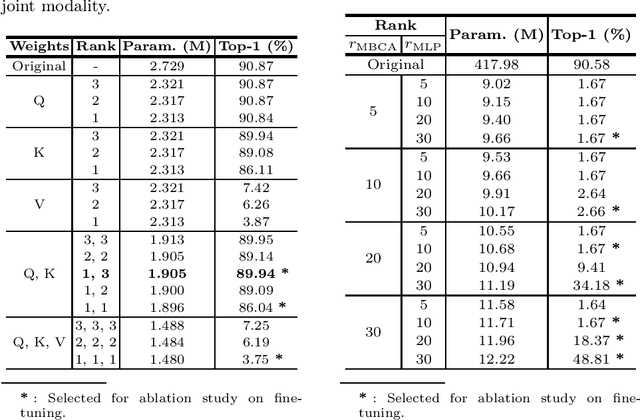
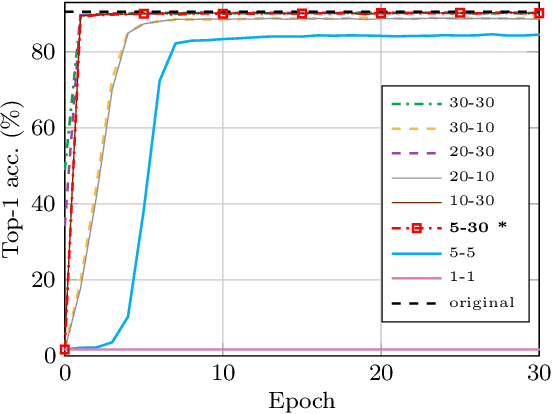
Abstract:The complexity of state-of-the-art Transformer-based models for skeleton-based action recognition poses significant challenges in terms of computational efficiency and resource utilization. In this paper, we explore the application of Singular Value Decomposition (SVD) to effectively reduce the model sizes of these pre-trained models, aiming to minimize their resource consumption while preserving accuracy. Our method, LORTSAR (LOw-Rank Transformer for Skeleton-based Action Recognition), also includes a fine-tuning step to compensate for any potential accuracy degradation caused by model compression, and is applied to two leading Transformer-based models, "Hyperformer" and "STEP-CATFormer". Experimental results on the "NTU RGB+D" and "NTU RGB+D 120" datasets show that our method can reduce the number of model parameters substantially with negligible degradation or even performance increase in recognition accuracy. This confirms that SVD combined with post-compression fine-tuning can boost model efficiency, paving the way for more sustainable, lightweight, and high-performance technologies in human action recognition.
ALPHAGMUT: A Rationale-Guided Alpha Shape Graph Neural Network to Evaluate Mutation Effects
Jun 13, 2024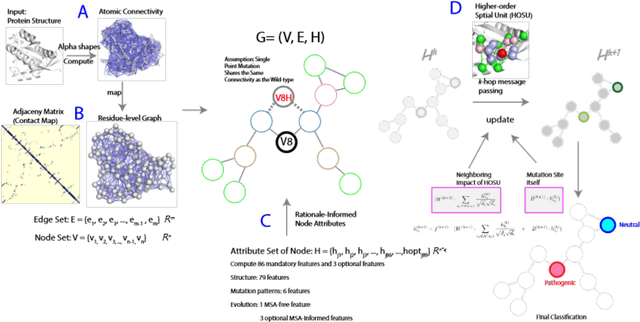



Abstract:In silico methods evaluating the mutation effects of missense mutations are providing an important approach for understanding mutations in personal genomes and identifying disease-relevant biomarkers. However, existing methods, including deep learning methods, heavily rely on sequence-aware information, and do not fully leverage the potential of available 3D structural information. In addition, these methods may exhibit an inability to predict mutations in domains difficult to formulate sequence-based embeddings. In this study, we introduce a novel rationale-guided graph neural network AlphaGMut to evaluate mutation effects and to distinguish pathogenic mutations from neutral mutations. We compute the alpha shapes of protein structures to obtain atomic-resolution edge connectivities and map them to an accurate residue-level graph representation. We then compute structural-, topological-, biophysical-, and sequence properties of the mutation sites, which are assigned as node attributes in the graph. These node attributes could effectively guide the graph neural network to learn the difference between pathogenic and neutral mutations using k-hop message passing with a short training period. We demonstrate that AlphaGMut outperforms state-of-the-art methods, including DeepMind's AlphaMissense, in many performance metrics. In addition, AlphaGMut has the advantage of performing well in alignment-free settings, which provides broader prediction coverage and better generalization compared to current methods requiring deep sequence-aware information.
NTIRE 2024 Restore Any Image Model in the Wild Challenge
May 16, 2024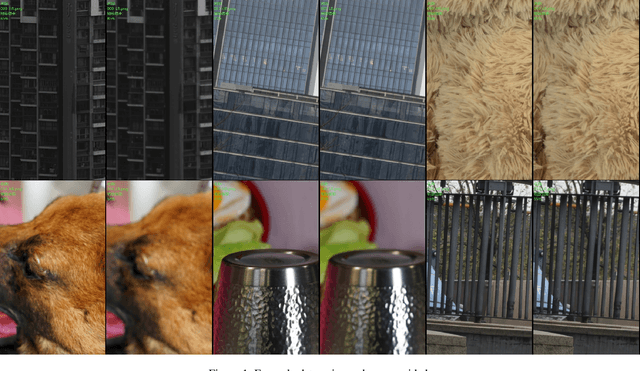
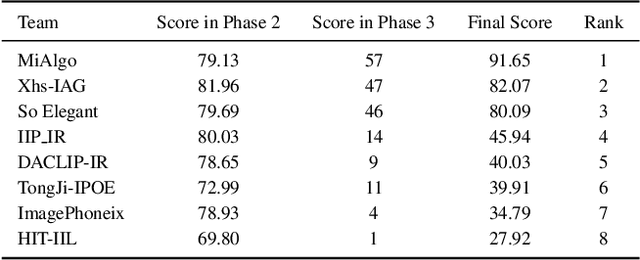
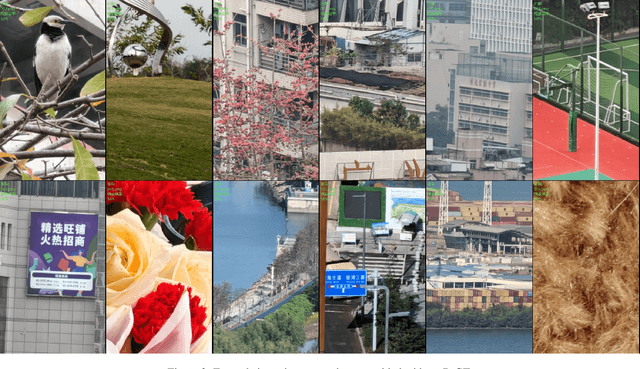
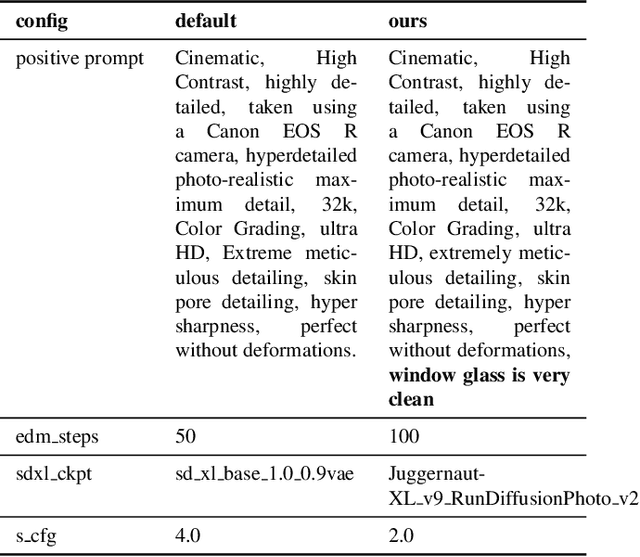
Abstract:In this paper, we review the NTIRE 2024 challenge on Restore Any Image Model (RAIM) in the Wild. The RAIM challenge constructed a benchmark for image restoration in the wild, including real-world images with/without reference ground truth in various scenarios from real applications. The participants were required to restore the real-captured images from complex and unknown degradation, where generative perceptual quality and fidelity are desired in the restoration result. The challenge consisted of two tasks. Task one employed real referenced data pairs, where quantitative evaluation is available. Task two used unpaired images, and a comprehensive user study was conducted. The challenge attracted more than 200 registrations, where 39 of them submitted results with more than 400 submissions. Top-ranked methods improved the state-of-the-art restoration performance and obtained unanimous recognition from all 18 judges. The proposed datasets are available at https://drive.google.com/file/d/1DqbxUoiUqkAIkExu3jZAqoElr_nu1IXb/view?usp=sharing and the homepage of this challenge is at https://codalab.lisn.upsaclay.fr/competitions/17632.
 Add to Chrome
Add to Chrome Add to Firefox
Add to Firefox Add to Edge
Add to Edge